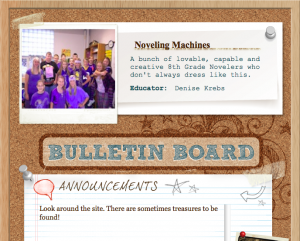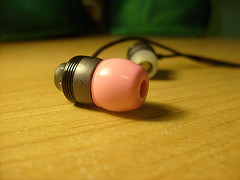The Virtual Classroom is loads of fun. It was new last year, and I learned how to use it with the help of good tutorials and plenty of NaNoMailing with the always helpful staff of the YWP. The how-to instructions for using the virtual classroom can be found here on the YWP NaNoWriMo site. The step-by-step explanations with screenshots are better than any I would give, so go with those. Questions? Ask me or Chris Angotti and staff.

Anyway, once I successfully set up my virtual classroom, I like to start out with a scavenger hunt late in October to get the students figuring out what’s available in our virtual classroom.
I send them to explore, where I have hidden a few items (in plain sight) using features I want them to practice.
In the Forum:
- Begin your first thread something like this…”Welcome to the Forum. We can have discussions here and reply to each other. Reply to this thread and tell something you are good at. Then see Mrs. Krebs for________.” (A sticker, extra credit on an assignment, a free-time pass, a sucker, or whatever suits your fancy.)
- Make a two-part post: Ask students to respond to a thread (favorite sport or favorite food or anything), and then, Part 2, reply to a reply of a friend. The goal for this is just to get them experimenting with the features of the Virtual Classroom.
- Ask students to upload an avatar to their author info for another prize or points good for something. Or add novel info or set their goal or whatever else in their profile you want them to complete.
In NaNoMail:
- Send a NaNoMail with something like this: “Send Mrs. Krebs a NaNoMail telling about one character who might be in your novel. When she reads it she’ll put a coupon for _______ in your mailbox.”
- Here’s another one: “When you read this NaNoMail, tell Mrs. Krebs your favorite color and she’ll give you a piece of gum.”
My goal in using this scavenger hunt is to get students familiar with the virtual classroom, to add their author and novel information and practice with NaNoMail and the Forums. When a student comes up and receives a stick of gum from me, others inevitably say, “Hey, how come s/he gets gum?” Then they quickly begin to dig a little deeper.
Links
The virtual classroom also has a section where you can add links for students to help them with their novel. Good ones I put in this section:
Name Generator
 Who is Yanko Nedelcho Borisov? A potential character in my novel thanks to the “Behind the Name” Random Name Generator. What a thesaurus does for adjectives, the Random Name Generator does for characters. I told the name generator that I wanted a Bulgarian man’s name–first, middle and last. They gave me Yanko Nedelcho Borisov. His wife is Zaharina, and his two children are Gardza and Marta. If I decide I don’t want Bulgarian characters, I can generate Frisian or French, Japanese or Jewish, Roman or rapper, hillbilly or hippy, and so many more! Great fun, especially when I need a lot of characters and get tired of using all the names of my friends and acquaintances.
Who is Yanko Nedelcho Borisov? A potential character in my novel thanks to the “Behind the Name” Random Name Generator. What a thesaurus does for adjectives, the Random Name Generator does for characters. I told the name generator that I wanted a Bulgarian man’s name–first, middle and last. They gave me Yanko Nedelcho Borisov. His wife is Zaharina, and his two children are Gardza and Marta. If I decide I don’t want Bulgarian characters, I can generate Frisian or French, Japanese or Jewish, Roman or rapper, hillbilly or hippy, and so many more! Great fun, especially when I need a lot of characters and get tired of using all the names of my friends and acquaintances.
Music
 I do not like to listen to music while I work or write. That may be a generational preference or that I just don’t regularly listen to music anytime. However, I appreciate that NaNoWriMo encourages us to consider what novel writing music we listen to, so I actually tried it a few times. Depending on what scene I wanted to write, I listened to some triumphant classical pieces or some sad and mellow ballads. I think it added a few hundred to my word count (especially during Beethoven’s 5th) and perhaps some inspiration, as well. I have links for AOL Radio and Pandora in my Virtual Classroom, so students can easily access music (even though Pandora is blocked at our school). They are allowed to bring headphones and mp3 players in November.
I do not like to listen to music while I work or write. That may be a generational preference or that I just don’t regularly listen to music anytime. However, I appreciate that NaNoWriMo encourages us to consider what novel writing music we listen to, so I actually tried it a few times. Depending on what scene I wanted to write, I listened to some triumphant classical pieces or some sad and mellow ballads. I think it added a few hundred to my word count (especially during Beethoven’s 5th) and perhaps some inspiration, as well. I have links for AOL Radio and Pandora in my Virtual Classroom, so students can easily access music (even though Pandora is blocked at our school). They are allowed to bring headphones and mp3 players in November.
So, that’s about all I’ve done to get ready to use my virtual classroom in November. How about you?
Can you share additional items for a virtual classroom scavenger hunt?
Do you have any helpful links for student novelers to share?
Photo credits: What’s in a Name? by Kathy Ponce & Headphones by Dylan Cantwell